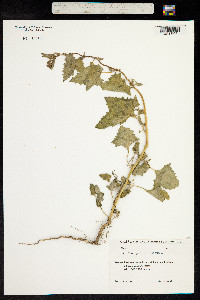
|
|
|
|
Family: Amaranthaceae
City Eurasian-Goosefoot, more...City Goosefoot
[Chenopodium rhombifolium, moreChenopodium urbicum L., Chenopodium urbicum var. intermedium (Mert. & W.D.J. Koch) W.D.J. Koch] |
Stems erect, simple or rarely branched, 3-10 dm, glabrous. Leaves nonaromatic; petiole 1.5-3.5 cm; blade mostly triangular or rhombic in proximal leaves, triangular, rhombic, or lanceolate in distal leaves, 3-11 × 3-10 cm, base truncate to broadly cuneate, margins sinuate to dentate (occasionally ± entire), often with obtuse to acute outward-pointing lobes at base, apex obtuse to acute, glabrous. Inflorescences glomerules in terminal panicles and lateral spikes or compound spikes, 3-4.5(-8) cm; glomerules subglobose, 2-3.5 mm diam.; bracts absent. Flowers: perianth segments 5, distinct nearly to base; lobes broadly ovate to elliptic, 0.6-0.8 × 0.4-0.8 mm, apex obtuse or retuse, rounded or with slight broad keel abaxially, glabrous, only slightly covering fruit at maturity; stamens 5; stigmas 2, 0.1 mm. Utricles depressed-ovoid; pericarp nonadherent, papillose to smooth. Seeds rarely few vertical, lenticular, round, 0.8-1.2 mm diam.; seed coat black (reddish brown), shiny. Fruiting late summer-fall. Waste places, especially about cities and towns, along railroad tracks; 0-600 m; introduced; N.S., Ont., Que.; Conn., Del., Ill., Ind., Iowa, Maine, Md., Mass., Mich., Mo., N.H., N.J., N.Y., Ohio, Pa., R.I., Vt., W.Va., Wis.; native to Europe, Asia; occasionally introduced in other parts of the world. Judging from its leaf morphology and anatomy, inflorescence structure, and floral characteristics, Chenopodium urbicum probably should be transferred to subg. Blitum, where it would occupy a position transitional toward subg. Chenopodium. Two rather distinct varie-ties are usually recognized: var. urbicum (= C. deltoideum Lamarck) with triangular leaf blades truncate at base, and var. intermedium (Mertens & Koch) Koch [= var. rhombifolium (Muhlenberg ex Willdenow) Moquin-Tandon] with rhombic leaf blades cuneate at base. Both entities occur in North America. Chenopodium urbicum has been reported from several other provinces and states including British Columbia, New Brunswick, Louisiana, Oregon, and Washington. We have not been able to verify these locations.
Annual herb 30 cm - 1 m tall Stem: upright, unbranched or sometimes branched. Leaves: alternate, on a 1.5 - 3.5 cm long stalk, 3 - 11 cm long, 3 - 10 cm wide, diamond-shaped or triangular (lower) to triangular, diamond-shaped, or lance-shaped (upper) with a flat to broadly tapering base and blunt to pointed tip, wavy to toothed along the margin, sometimes with blunt to pointed basal lobes. Inflorescence: a 2 - 3.5 mm wide, nearly round cluster of flowers (glomerule), which together form compound spikes, lateral spikes, or terminal branched inflorescences (panicles) that are 3 - 8 cm long. Flowers: greenish, small, with five nearly distinct sepals and no petals. Sepal lobes about 0.5 mm long and wide, elliptic to broadly egg-shaped with a blunt or shallowly notched apex, rounded or slightly keeled beneath, smooth or white-mealy. Stamens five. Stigmas two. Fruit: one-seeded, slightly enclosed in the persistent, incurved sepals, depressed egg-shaped, thin-walled. Wall (pericarp) not adhered to the seed. Seed mostly horizontal, dark reddish brown, shiny, 0.8 - 1.2 mm wide, lenticular (lens-shaped), round-margined. Similar species: No information at this time. Flowering: July to October Habitat and ecology: Introduced from Europe. Rare in the Chicago Region. Found in waste ground. Occurence in the Chicago region: non-native Etymology: Chenopodium comes from the Greek words chen, meaning goose, and podion, meaning "little foot," referring to the leaf shape of some species. Urbicum means urban or "belonging to a city or town." Author: The Morton Arboretum Erect annual 3-10 dm; lvs on short or long petioles, triangular to rhombic-ovate or lanceolate, acute, sharply and coarsely toothed, truncate or cuneate at base, shining above, usually slightly white-mealy beneath when young, to 8 נ5 cm; cal smooth or white-mealy, its 5 segments rounded on the back; seeds horizontal, shiny dark brown, rounded at the margin, 1.0-1.2 mm wide; 2n=18, 36. Native of Europe, sparingly intr. in waste places in our range. Gleason, Henry A. & Cronquist, Arthur J. 1991. Manual of vascular plants of northeastern United States and adjacent Canada. lxxv + 910 pp. ©The New York Botanical Garden. All rights reserved. Used by permission. From Flora of Indiana (1940) by Charles C. Deam Introduced in America. Reported from Clark, Jefferson, Kosciusko, Marion, Monroe, Pulaski, Steuben, Tippecanoe, and Vigo Counties. [Deam reports the introduced species Chenopodium vulvaria L., without specimen reference,] from Monroe and Noble Counties. ...... Indiana Coefficient of Conservatism: C = null, non-native Wetland Indicator Status: UPL Diagnostic Traits: leaves somewhat deltate, coarsely sinuate-toothed or incised, glabrous or sparsely farinose beneath; sepals 5, green or farinose; fruits horizontal; seeds to 1.2 mm wide, dark-brown or black. |
This project was made possible in part by the Institute of Museum and Library Services [MG-70-19-0057-19].
Powered by Symbiota

















































































